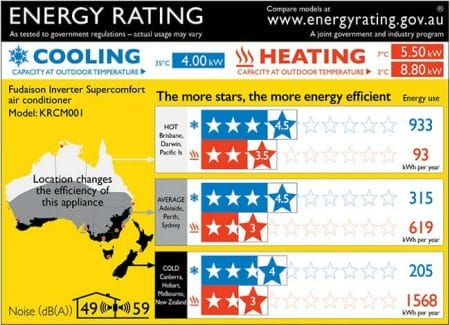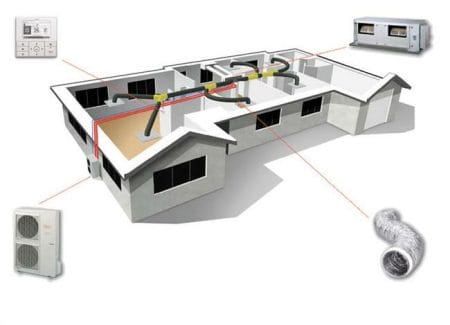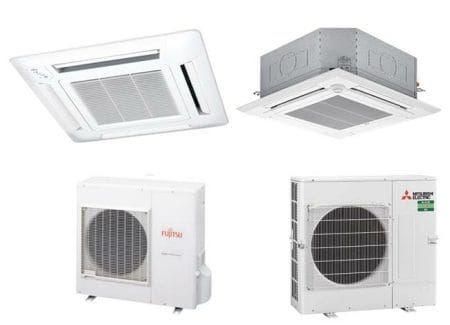Air Conditioner Buying Guide
Staying cool during the hot summer months can be tough in Australia. If you want to sleep well and feel comfortable, you may want to buy an air conditioning unit. But with so many options available, it can be hard to choose the right one for your needs. That’s why we created this Air Conditioners Buying Guide.
When you’re buying an air conditioner, there are many things to think about. The size of the room, how many windows it has, how much noise it makes, how it connects to other devices, and the price are all important factors to consider.
In this air conditioners buying guide, we’ll cover everything you need to know to choose the perfect air conditioner for you.
Firstly, how does an air conditioner work?
When you turn on an air conditioner, it pulls hot air from the room inside and cools it down using a cold coil and a special chemical called refrigerant. This cooling process also removes some of the moisture from the air, making it feel less sticky. Then, the air conditioner blows the cool air back into the room while the outdoor condenser rejects hot air.
The air conditioner will keep working until it reaches the temperature you set on the thermostat. Once it reaches the desired temperature, it will turn off automatically. But if the temperature starts to go up again, the air conditioner will turn back on to keep your room cool and comfortable.
Different Types of Air Conditioners
Exploring the Various Types of Air Conditioners: Which One Is Right for You?
 1. Split Air Conditioners
1. Split Air Conditioners
Wall split air conditioners are made up of two parts: an indoor unit that’s mounted on the wall, and an outdoor unit that’s connected to the indoor unit with insulated pair copper. The outdoor unit can be installed on a wall or on the ground, as long as there’s enough space.
Because they’re not portable, split air conditioner systems need to be installed by a professional. But they’re a great choice for people who want to save floor space and have a quieter air conditioning system. They work well in modern, open-plan spaces, conservatories, or commercial properties. Plus, they can also heat your room when it’s cold outside being reverse cycle .
Here are some benefits of wall split air conditioners:
-
-
- They’re quieter than portable units.
- They’re more efficient than portable units.
- They cool your room better.
- They don’t take up floor space.
- There’s no visible ducting in the room.
- You don’t need a window venting kit.
- You can control them with a remote, app, or even your voice.
-
View all Split Air Conditioners
 2. Ducted Air Conditioners
2. Ducted Air Conditioners
Ducted air conditioners have two parts: an indoor unit and an outdoor condensing unit. The indoor unit is hidden in your ceiling space, and it’s connected to ducts that run through your walls or roof to reach each room. The outdoor unit can be installed wherever it has space, usually outside or on the roof.
Ducted air conditioning systems are a good option if you want to cool your entire home or office, rather than just one room. They’re also quieter than portable units, and they don’t take up any floor space. They work well in modern open plan homes, large offices, and commercial properties.
In addition to cooling your space, ducted air conditioners can also heat your home during the colder months. Other benefits include:
-
-
- Cooling for the entire home or office: Ducted air conditioners can cool an entire home or office, unlike wall split or portable air conditioners that are designed for a single room.
- Quieter operation: Ducted air conditioners are generally quieter than wall split or portable air conditioners. This is because the noise is generated outside of the home or office.
- More efficient: Ducted air conditioners are generally more efficient than wall split or portable air conditioners, resulting in lower energy bills.
- Better cooling output : Ducted air conditioners are designed to deliver better cooling output than wall split or portable air conditioners, ensuring that you stay cool and comfortable during the hot summer months.
- No visible ducting : flexible duct is all hidden within ceiling cavity.
- No need for a window venting kit: Portable air conditioners require a window venting kit, which can be unsightly and inconvenient. Ducted air conditioners require no such kit.
- Multiple control options: Ducted air conditioners can be controlled via remote, app, or voice, giving you greater flexibility and convenience.
- Increase property value: Installing a ducted air conditioner can increase the value of your property, making it an investment in your home or office that pays off in the long run.
-
View all Ducted Air Conditioners
 3. Ceiling Cassette Air Conditioners
3. Ceiling Cassette Air Conditioners
Ceiling cassette air conditioners are a type of air conditioning unit that is installed in the ceiling of a room, with only the grille visible. They are ideal for spaces with limited wall space and are often used in commercial settings such as offices, retail stores, and restaurants.
Ceiling cassette air conditioning systems are designed to provide efficient and even cooling, with multiple airflow directions and customizable controls. They are typically more expensive than other types of air conditioners, but offer a sleek and unobtrusive design that can blend seamlessly with any interior décor.
-
-
- The unit is installed in the ceiling, freeing up valuable wall space.
- The sleek design blends in seamlessly with any interior décor.
- Multiple airflow directions provide efficient and even cooling throughout the room.
- Customizable controls allow for precise temperature and humidity control.
- The quiet operation is ideal for commercial settings like offices, retail stores, and restaurants.
- Advanced features like Wi-Fi and voice control are available on some models.
- Easy maintenance and cleaning due to accessible filters and parts.
- The unit can also function as a heater, providing year-round comfort.
-
View all Ceiling Cassette Air Conditioners
There are several other types of air conditioners also available based on your application , some of them are Floor Consoles, Window Wall Air Conditioners, Portable Air Conditioners, Commercial Rooftop Packages.
How powerful should an air conditioner be?
Finding the right cooling power: This air conditioners buying guide can help for choosing the correct size air conditioner for your space.
To cool down a living space or room, Consumer Reports suggests having 20 BTUs per square foot. But don’t worry about doing any complicated math because here is a list that can help determine how much approx. air conditioning power you need based on the room’s size.
| A Class | B Class |
| Insulated roof space, walls and sub floor, full brick or brick veneer construction, average size windows with awnings, full shading south facing aspect, temperate weather conditions. | Insulated roof space, full brick or brick veneer construction, average size windows with internal shades, north facing aspect, temperate climate. |
| C Class | D Class |
| Insulated roof space, full brick or brick veneer construction, average size windows with internal shades, east facing aspect or sub tropical climate. | Little or no insulation, weatherboard, fibro or brick veneer construction, large windows, no shading from the sun westerly facing aspect. |
| Air Conditioner Capacity | Room Class | ||||
| A | B | C | D | ||
| Maximum Floor Area (m2) | |||||
| 1.7kW | Cooling | 17 | 14 | 12 | 10 |
| Heating | 20 | 17 | 15 | 12 | |
| 2.0kW | Cooling | 20 | 16 | 14 | 12 |
| Heating | 27 | 23 | 20 | 16 | |
| 2.5kW | Cooling | 25 | 21 | 18 | 15 |
| Heating | 34 | 28 | 24 | 20 | |
| 3.5kW | Cooling | 35 | 29 | 25 | 21 |
| Heating | 40 | 33 | 29 | 24 | |
| 5.0kW | Cooling | 51 | 43 | 36 | 30 |
| Heating | 58 | 48 | 41 | 34 | |
| 6.0kW | Cooling | 60 | 50 | 45 | 37 |
| Heating | 68 | 57 | 48 | 39 | |
| 7.1kW | Cooling | 71 | 59 | 51 | 42 |
| Heating | 80 | 67 | 57 | 47 | |
| 8.0kW | Cooling | 80 | 67 | 57 | 47 |
| Heating | 89 | 73 | 64 | 52 | |
| 9.5kW | Cooling | 95 | 78 | 68 | 57 |
| Heating | 105 | 87 | 76 | 60 | |
| 10.0kW | Cooling | 100 | 83 | 73 | 62 |
| Heating | 110 | 92 | 81 | 68 | |
Note: These size are just for reference and may vary depending the window sizes, insulation types, region etc.
When selecting an air conditioner for a room, it is recommended to choose a model with equal or slightly greater capacity for the room. For example, if the calculation shows that the room requires a 6kW model, it is better to choose a model that has slightly more capacity rather than less. This extra capacity may come in handy during extreme temperatures. However, it is not advisable to choose a model with a significantly higher capacity than required.
A proper calculation takes various factors into account, such as the size and type of the room, the size and orientation of the windows and glass doors, the shading and curtains on the windows, the insulation of the floor, ceiling, and walls, and the local climate.
By considering all of these details in air conditioners buying guide, you can choose the right air conditioner that will be efficient and effective in cooling your room.
Saving Energy and Money: The Benefits of Energy Efficient Air Conditioners
The energy efficiency of air conditioners is measured and rated by the Australian government’s Energy Rating system, which provides consumers with an easy way to compare the energy efficiency of different models. The system rates air conditioners on a scale of 1 to 6 stars, with more stars indicating greater energy efficiency.
Minimum Energy Performance Standards

The Minimum Energy Performance Standards for this Determination are established in Division 2 and Schedule 1 of the Determination.
Depending on the product class and type of air conditioner, the air conditioner must meet minimum annual coefficient of performance (ACOP) or coefficient of performance (COP) values for heating, and minimum annual energy efficiency ratios (AEER) or energy efficiency ratios (EER) for cooling.
AEER is defined as the ratio of the cooling capacity to the effective power input for cooling plus standby power. EER is the ratio of the cooling capacity to the power input.
ACOP is defined as the ratio of the heating capacity to the effective power input for heating plus standby power. COP is the ratio of the heating capacity to the power input.
Reading Zoned Energy Rating Labels
At the top of the label, output capacity is provided for heating at two outdoor temperatures and cooling at one outdoor temperature.
Estimated annual energy use in kilowatt hours or kWh is provided on the right of the label, for heating (red) and cooling (blue) in each climate zone.
In addition, there are noise indicators at the bottom left to show the volume in decibels (dB(A)) of the internal and external units of the air conditioner.
Get installed by a professional installer
.In Australia, you are required to have an ARC (Australian Refrigeration Council) license to install or service any air conditioning system that contains refrigerant gas. The ARCtick license ensures that the person performing the installation or service is properly trained and qualified to handle the refrigerant gas and equipment. It is illegal to install or service air conditioning systems without a valid ARCtick license in Australia.
If you need your new split or Ducted air conditioner system installed quickly, our professional & ARCtick licensed installers at Airconditioning-Online can assist you with installation. The installation work is guaranteed, and there is no need to worry about any mess.
Contact us for Air Conditioner Installation Service.
Why Look at a Air Conditioner Buying Guide?
If you are in the market for an air conditioner, then the “Air Conditioner Buying Guide” is a must-read before making your purchase. This guide provides valuable information on the different types of air conditioners available, their energy efficiency ratings, installation requirements, and maintenance tips. By going through this guide, you can ensure that you make an informed decision and choose an air conditioner that meets your needs while also being energy-efficient and cost-effective in the long run. Don’t make the mistake of buying an air conditioner without consulting this guide first!



















 1. Split Air Conditioners
1. Split Air Conditioners 2. Ducted Air Conditioners
2. Ducted Air Conditioners 3. Ceiling Cassette Air Conditioners
3. Ceiling Cassette Air Conditioners